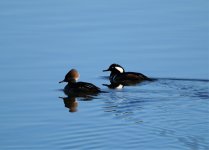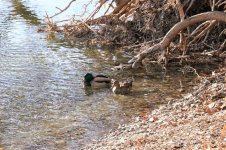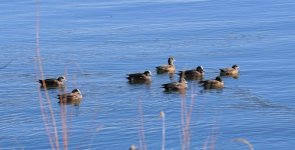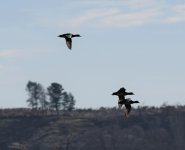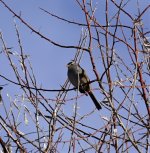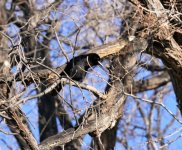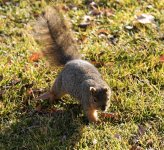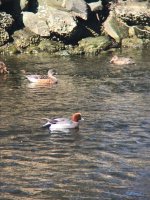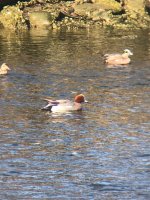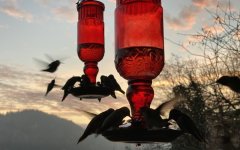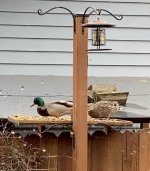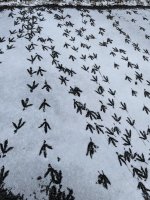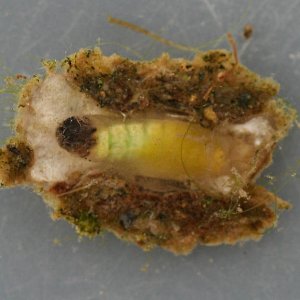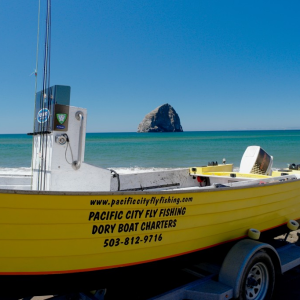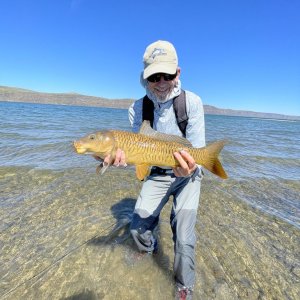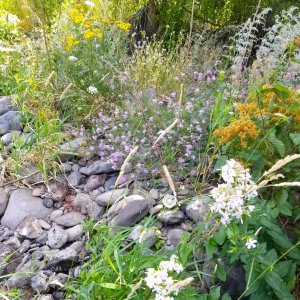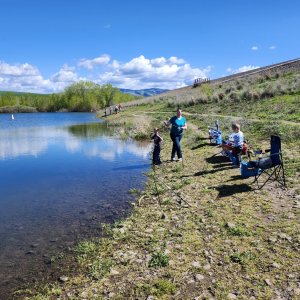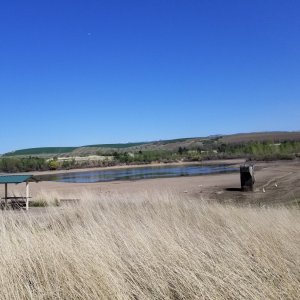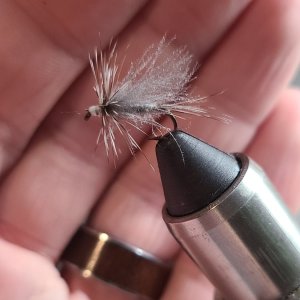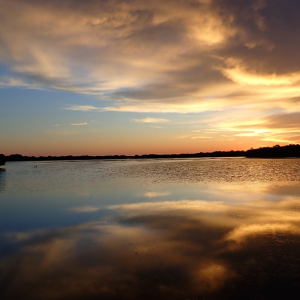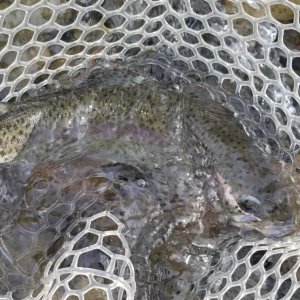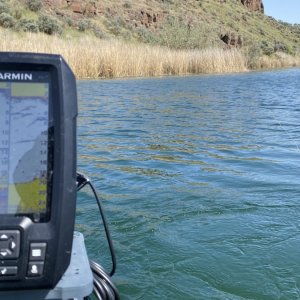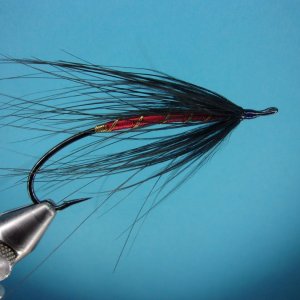You are using an out of date browser. It may not display this or other websites correctly.
You should upgrade or use an alternative browser.
You should upgrade or use an alternative browser.
Backyard Wildlife
- Thread starter Canuck from Kansas
- Start date
BriGuy
Life of the Party
Velociraptors?What does anyone think this is. Bank of the lower YakimaView attachment 3405View attachment 3406
Gyrfalcon22
Life of the Party
Indeed, Jim! Things are really moving along to Spring as many birds I see now are pairing and/or getting into display flights (harriers) as the longer days have arrived. Only time of year I see herons on top of perches usually reserved for raptors. Love that shot of the Hooded mergansers-one of the neatest little ducks around. Today, had a pairing of another small favorite in a set of Green-winged teal. So interesting how the green speculum feathers become blue when the angle of light changes.Appears that most of the Widgeon have moved out. Lots of Geese are paired-up, as were these Mergansers.
View attachment 5541
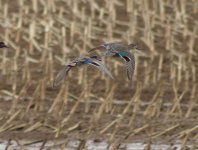
The Golden eagle is still around and made a dash through our fields (right) off the deck today. Will be interesting to see how much longer it stays now.
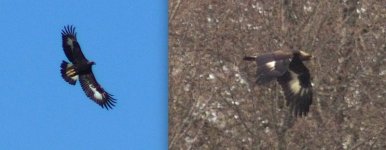
Last edited:
Jim F.
Still a Genuine Montana Fossil
"Camp Meat" - two of these tree rats were, uh, cavorting in the neighbor's tree. He thinks squirrels are cute. Nice picture!!
No photos, but had the opposite of the popular drake this fall hunting. Three mallards landed near the decoys but out of range. Two drakes and a hen. As soon as they landed, one of the drakes put the beat down on the other drake. Kept hitting him with his wing and pushing him underwater. The fight was loud and prolonged. The aggressor clearly had the upper ”wing.” Meanwhile, the hen swam around nearby calling softly. This went on for about 5 minutes and the abused drake finally flew off. The other two swam upstream to their honeymoon cottage on the next point upstream. It was about the funniest thing I’ve experienced in a duck blind, but not too funny because the squabble led to other flocks not wanting to land with all the commotion. Not sure that a camera would have done it justice….Thanks to @RichS , I visited a place that I haven't been to in years. I found no Spotted Towhee, did end up with a mixed bag during a walk. Next time I'll take my big lens. Thank you Rich!
This Drake Mallard must be popular
View attachment 5859
The Widgeon are still around
View attachment 5860
View attachment 5861
I keep my telephoto camera by my desk because you never know what will come by. There is a red fox that trots by my window every so often but too quick to capture. But this northern flicker stayed in view long enough for some nice pictures.
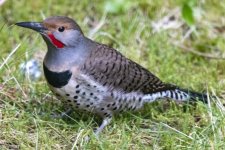
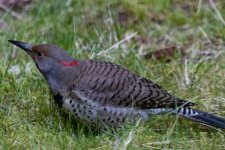
When I first took the images, I didn't see anything that I viewed as unusual. But when I reviewed the pictures, I was struck by the red nape patch, something that I had never seen before in PNW flickers. This is an intergrade bird, an individual with a mix of features from the eastern (yellow-shafted) and western (red-shafted) subspecies. In the eastern subspecies, the face/ear patch is brown, the malar stripe ("mustache") is black, the shafts of the flight feathers are yellow, and they have a red nape (posterior neck) patch. In the western subspecies, the face is gray, the malar stripe is red, the shafts of the flight feathers are red, and they have a simple gray nape. This bird has all the typical western red-shafted characteristics but it does have the red nape patch of a yellow-shafted subspecies.
When I was first learning to bird, these were considered separate species that evolved due to isolation during Pleistocene glaciation and the development of the Great Plains which isolated eastern and western forest bird populations. But, as human influence transformed the Great Plains from a tree-less grassland, these formerly isolated populations have spread east and west. The few genetic / coloration differences that appeared when the populations were in isolation are not enough to prevent interbreeding and hence the status as a single species and the appearance of intergrades, like this one.
Steve
P.S., I was just looking at a picture of a Northern flicker that I took Friday morning at Billie Franks Jr. Nisqually Wildlife Refuge and it is another intergrade with mostly red-shafted features but a red nape.


When I first took the images, I didn't see anything that I viewed as unusual. But when I reviewed the pictures, I was struck by the red nape patch, something that I had never seen before in PNW flickers. This is an intergrade bird, an individual with a mix of features from the eastern (yellow-shafted) and western (red-shafted) subspecies. In the eastern subspecies, the face/ear patch is brown, the malar stripe ("mustache") is black, the shafts of the flight feathers are yellow, and they have a red nape (posterior neck) patch. In the western subspecies, the face is gray, the malar stripe is red, the shafts of the flight feathers are red, and they have a simple gray nape. This bird has all the typical western red-shafted characteristics but it does have the red nape patch of a yellow-shafted subspecies.
When I was first learning to bird, these were considered separate species that evolved due to isolation during Pleistocene glaciation and the development of the Great Plains which isolated eastern and western forest bird populations. But, as human influence transformed the Great Plains from a tree-less grassland, these formerly isolated populations have spread east and west. The few genetic / coloration differences that appeared when the populations were in isolation are not enough to prevent interbreeding and hence the status as a single species and the appearance of intergrades, like this one.
Steve
P.S., I was just looking at a picture of a Northern flicker that I took Friday morning at Billie Franks Jr. Nisqually Wildlife Refuge and it is another intergrade with mostly red-shafted features but a red nape.
Last edited:
Pink Nighty
Life of the Party
Hi tkww,Any lucking finding a Eurasian? I keep seeing them pop up in the tri-cities birding reports.
My wife and I saw one Eurasian drake in a flock of American wigeons at Nisqually Wildlife Refuge on Friday. See https://pnwflyfishing.com/forum/ind...squally-wildlife-refuge-25-february-2022.708/.
Steve
Finally replaced my POS dying phone with a new Samsung S22. Tested the optical zoom at 3x on the parking lot deer leaving work in the wee hours the other morning. Guessing the combo of street lamp lighting, rain, and taken from a moving vehicle explains the grainy quality. The resolution in normal light is incredible (for a phone).
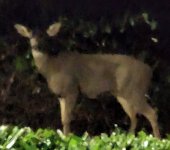

Last edited:
tkww
Steelhead
It's great to see optical zooms coming to phones. But at the end of the day they still have really small sensors (very little light collection), so dark conditions are still going to be their Achilles' heel.Finally replaced my POS dying phone with a new Samsung S22. Tested the optical zoom at 3x on the parking lot deer leaving work in the wee hours the other morning. Guessing the combo of street lamp lighting, rain, and taken from a moving vehicle explains the grainy quality. The resolution in normal light is incredible (for a phone).
View attachment 7484

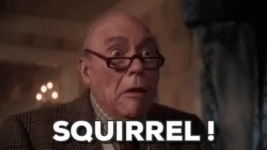
.jpg)
